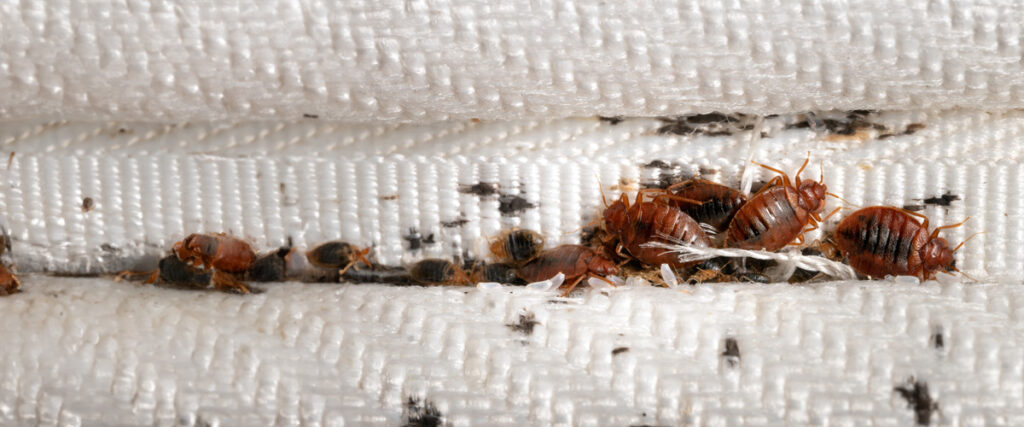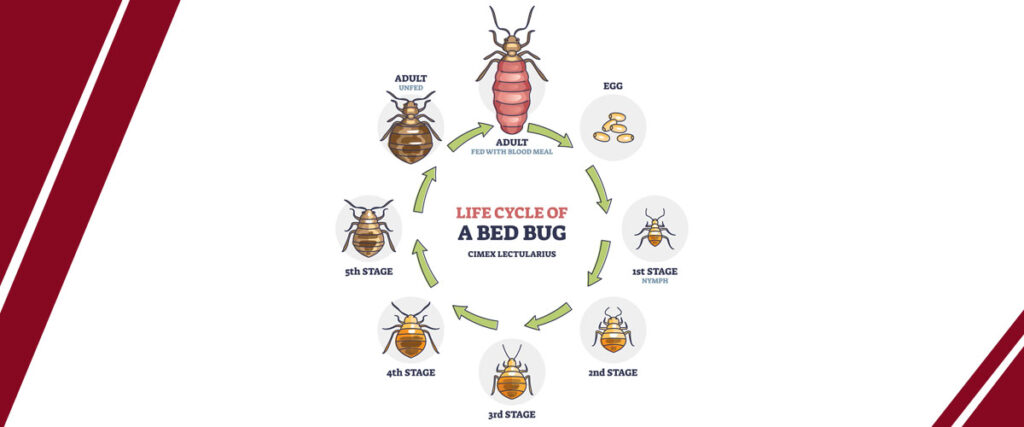Tiny Hitchhikers: The Intricate Lifecycle Journey of Bed Bugs
You know those pesky hitchhikers that always seem to spoil your good night’s sleep? Yep, you guessed it – we’re talking about bed bugs! Strap in because we’re about to take you on a thrilling ride through the fascinating world of bed bugs and their intricate lifecycle journey. Without warning, bed bugs, those resilient and relentless creatures we deem unwelcome guests, can invade our homes. Their uncanny ability to hitchhike into any environment has also earned their reputation as household pests.
Furthermore, this captivating article will also delve into Wisconsin’s Lifecycle of bed bugs and discover its implications for infestation and control. Brace yourself for a journey of knowledge and empowerment in the battle against bed bugs.

Understanding Bed Bugs
Bed bugs are tiny, reddish-brown creatures with an insatiable appetite that courses through humans and animals. They also have a flat, oval-shaped body and are about the size of an apple seed. Bed bugs commonly infest mattresses, furniture, and wall cracks.
Bed bugs are a significant concern in residential and commercial settings due to the following reasons:
- They prefer to feed on human blood, but they can also survive by feeding on the blood of other warm-blooded animals.
- The psychological consequences of living with bed bugs can also be substantial, leading to anxiety, stress, and disturbances in sleep.

The Lifecycle Stages of Bed Bugs
Understanding the stages of bed bugs is crucial for effective control and prevention strategies. Like Wisconsin’s Lifecycle of bed bugs, it has three main stages:
- Egg: Bed bug eggs are laid in hidden areas, facilitating survival and making detection challenging. Additionally, the ease of transporting eggs contributes to the spread of bed bugs.
- Nymph: Nymphs undergo molting, increasing in size with each stage. They also require blood meals to survive, and their small size aids in spreading.
- Adult: Adults are fully grown and can reproduce. Because of their ability to produce, they may go for extended periods without eating, conceal themselves, and spread swiftly.

Reproduction and Growth
Bed bugs’ unique reproductive process contributes to their rapid population growth. Additionally, mating usually occurs through traumatic insemination, where the male pierces the female’s abdomen to inseminate her. The female bed bug can experience physical damage due to this process.
The following factors influence their growth and development, including:
- Temperature between 70 and 90 degrees Fahrenheit accelerates their growth.
- Regular blood meals provide nutrients for molting and developing into adult bed bugs.

Feeding and Survival Tactics
Bed bugs are primarily nocturnal feeders, seeking out their hosts at night. Humans release carbon dioxide and heat when they sleep, which attracts bed bugs. Their feeding behavior includes:
- They pierce the skin and feed on blood using their elongated mouthparts, known as the proboscis.
- After feeding, bed bugs retreat to their hiding places to digest the blood meal.
Additionally, the survival tactics of bed bugs include their ability to endure prolonged periods without feeding, thanks to a dormancy state called diapause. During diapause:
- Without feeding, bed bugs can last for several months.
- This survival tactic makes it difficult to eliminate infestations as they can also remain hidden and dormant, waiting for an opportunity to feed.

Detection and Early Signs
Detecting bed bugs is crucial in effectively managing an infestation. Look out for the following signs:
- Bite marks – Look for small, itchy red welts on your skin.
- Blood spots on bedding – Check for tiny reddish-brown stains on sheets or pillowcases.
- Sightings of bugs or eggs – Inspect your mattress, furniture, and walls for live bugs or tiny white eggs.
The importance of early detection in effectively managing a bed bug infestation includes:
- It prevents the infestation from worsening and spreading.
- It minimizes discomfort caused by bites.
- It also reduces the need for more extensive and costly treatments.

The Challenges in Controlling Bed Bugs
Controlling and eliminating bed bugs can be challenging due to several factors. The following are the challenges faced in managing bed bugs:
- The bed bug lifecycle, with multiple stages, requires targeting each stage for effective elimination.
- Their rapid reproduction leads to a quickly growing population if not promptly addressed.
- Their ability to hide in cracks and furniture makes locating and treating all infested areas challenging.
Here are reasons why DIY methods often fall short and the need for professional intervention:
- DIY methods may not target all life stages or reach hidden areas.
- Over-the-counter sprays and insecticides may have limited efficacy against bed bugs.
- Lack of specialized knowledge and equipment can also result in incomplete treatment.
Moreover, professional intervention is necessary to assess and effectively eradicate bed bugs thoroughly.
Preventive Measures Against Bed Bugs
Reducing the risk of bed bug infestations is greatly influenced by prevention measures. Here are some preventive measures to consider:
- Regular inspections – Conduct routine inspections of sleeping areas, including mattresses, bed frames, and furniture, to detect early signs of bed bug activity.
- Minimize clutter – Reduce clutter in living spaces to minimize hiding spots for bed bugs.
- Vigilance during travel – Inspect hotel rooms and luggage upon arrival and departure to prevent bringing bed bugs home.
Awareness and preventive measures play a crucial role in controlling bed bugs. Educating ourselves about their habits and taking proactive steps to prevent infestations can significantly reduce the risk and impact of bed bug problems.

Professional Bed Bug Treatment Options
When confronted with a bed bug infestation, seeking professional treatment is often necessary. Pest control professionals may also employ different treatment options depending on the severity of the infestation. These treatment options include:
- Heat treatment – involves raising the infested area’s temperature to a level lethal to bed bugs.
- Chemical treatments – Professional exterminators use insecticides to treat affected areas and kill bed bugs.
- Integrated Pest Management (IPM) – This approach combines techniques, including thorough inspection, monitoring, and targeted treatments.
A comprehensive approach tailored to the specific bed bug infestation is crucial for effectively eradicating and preventing re-infestation. It is essential to consider the following to accomplish this:
- Infestation’s severity
- The affected area’s size
- The type of environment

Understanding the Resilience of Bed Bugs
These resilient pests have perplexed homeowners and professionals alike. These are the factors that contribute to the remarkable resilience of bed bugs, such as:
- Resistance to specific pesticides through genetic mutations.
- Ability to thrive in various environments, including homes, hotels, and hospitals.
Additionally, ongoing research focuses on understanding bed bug resistance mechanisms and developing new pesticides. Evolving strategies include the following:
- Integrated pest management approaches
- Public education on prevention and early detection.

Navigating the Bed Bug Lifecycle
In conclusion, understanding bed bugs’ lifecycle and survival tactics is crucial for effective control and prevention. Early detection, professional intervention, and preventive measures are essential in managing bed bug infestations.
Furthermore, individuals can minimize the likelihood of bed bug infestations and detect potential issues early by being proactive and staying informed.
References:
- Bed bugs appearance and life cycle | US EPA. (2023, February 15). Retrieved from https://www.epa.gov/bedbugs/bed-bugs-appearance-and-life-cycle
- Potter, M. F. (2020). Bed bugs | Entomology. Retrieved from https://entomology.ca.uky.edu/ef636
- Bed bug life cycle. (n.d.). Retrieved from https://infinitylearn.com/surge/biology/bed-bug-life-cycle/







